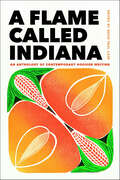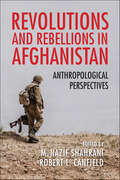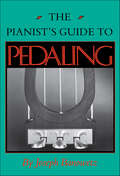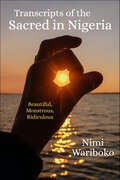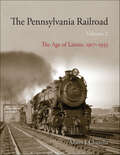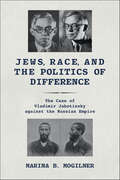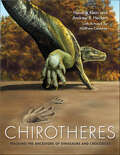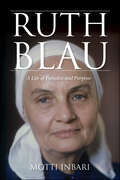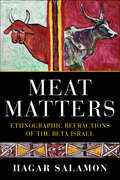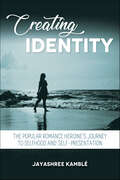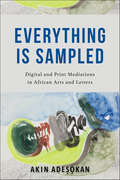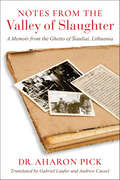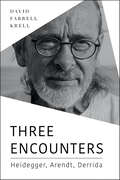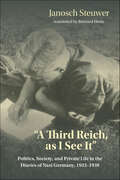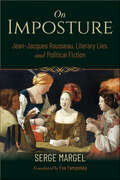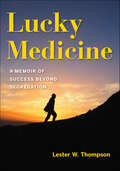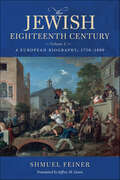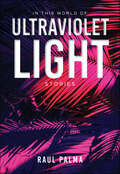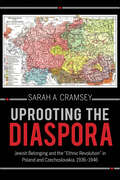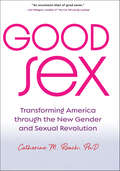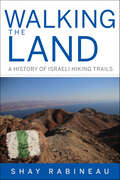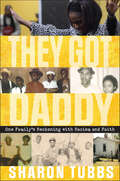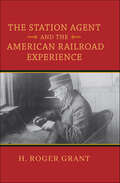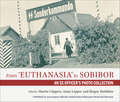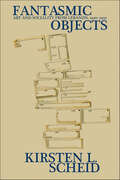- Table View
- List View
A Flame Called Indiana: An Anthology of Contemporary Hoosier Writing
by Doug Paul CaseAs Kurt Vonnegut, Indiana's most famous writer, once remarked, "Wherever you go, there is always a Hoosier doing something important there."A Flame Called Indiana features 65 writers of fiction, nonfiction, and poetry who have all had the pleasure of being Hoosiers at one time or another. Curated by the Indiana University Bloomington creative writing department, this diverse anthology features everything from the immigrant experience to the Indianapolis 500 to science fiction. Altogether, the work stands testament to the vibrancy and creativity of this Midwest state.An excellent gift for your favorite reader and an important resource for creative writers, A Flame Called Indiana serves as both a chronicle of where Indiana's writing is today and a beacon to those who'll take it where it's going next.
Revolutions and Rebellions in Afghanistan: Anthropological Perspectives
by M. Nazif Shahrani and Robert L. CanfieldWhen originally published in 1984, Revolutions and Rebellions in Afghanistan provided the first focused consideration of the 1978 Saur Revolution and the subsequent Soviet invasion and occupation of the country. Nearly four decades later, its conclusions remain crucial to understanding Afghanistan today.In this much-anticipated re-release, Revolutions and Rebellions in Afghanistan offers an opportunity for fresh insight into the antecedents of the nation's enduring conflicts. A new foreword by editors M. Nazif Shahrani and Robert L. Canfield contextualizes this collection, which relies on extensive fieldwork in the years leading up to the Soviet invasion. Specific tribal, ethnic, and gender groups are considered within the context of their region, and contributors discuss local responses to government decrees, Islamic-inspired grassroots activism, and interpretations of jihad outside of Kabul. Long recognized as a vital ethnographic text in Afghan studies, Revolutions and Rebellions in Afghanistan provides an extraordinary chance to experience the diversity of the Afghan people on the cusp of irrevocable change and to understand what they expected of the years ahead.
The Pianist's Guide to Pedaling
by Joseph Banowetz" . . . a most precious book which every serious pianist and teacher must own." —Journal of the American Liszt SocietyJoseph Banowetz and four distinguished contributors provide practical suggestions and musicological insights on the pedaling of keyboard works from the 18th to the 20th century.
Transcripts of the Sacred in Nigeria: Beautiful, Monstrous, Ridiculous
by Nimi WaribokoTranscripts of the Sacred in Nigeria explores how the sacred plays itself out in contemporary Africa. It offers a creative analysis of the logics and dynamics of the sacred (understood as the constellation of im/possibility available to a given community) in religion, politics, epistemology, economic development, and reactionary violence. Using the tools of philosophy, postcolonial criticism, political theory, African studies, religious studies, and cultural studies, Wariboko reveals the intricate connections between the sacred and the existential conditions that characterize disorder, terror, trauma, despair, and hope in the postcolonial Africa.The sacred, Wariboko argues, is not about religion or divinity but the set of possibilities opened to a people or denied them, the sum total of possibilities conceivable given their level of social, technological, and economic development. These possibilities profoundly speak to the present political moment in sub-Saharan Africa.
The Pennsylvania Railroad, Volume 2: The Age of Limits, 1917–1933 (Railroads Past and Present)
by Albert J. ChurellaBy 1933, the Pennsylvania Railroad had been in existence for nearly ninety years. During this time, it had grown from a small line, struggling to build west from the state capital in Harrisburg, to the dominant transportation company in the United States. In Volume 2 of The Pennsylvania Railroad, Albert J. Churella continues his history of this giant of American transportation. At the beginning of the twentieth century, the Pennsylvania Railroad was the world's largest business corporation and the nation's most important railroad. By 1917, the Pennsylvania Railroad, like the nation itself, was confronting a very different world. The war that had consumed Europe since 1914 was about to engulf the United States. Amid unprecedented demand for transportation, the federal government undertook the management of the railroads, while new labor policies and new regulatory initiatives, coupled with a postwar recession, would challenge the company like never before. Only time would tell whether the years that followed would signal a new beginning for the Pennsylvania Railroad or the beginning of the end. The Pennsylvania Railroad: The Age of Limits, 1917–1933,represents an unparalleled look at the history, the personalities, and the technologies of this iconic American company in a period that marked the shift from building an empire to exploring the limits of their power.
Jews, Race, and the Politics of Difference: The Case of Vladimir Jabotinsky against the Russian Empire (Jews in Eastern Europe)
by Marina B. MogilnerJews, Race, and the Politics of Difference explores how Russian Jewish writers and political activists such as Vladimir Jabotinsky turned to "race" as an operational concept in the late imperial politics of the Russian Empire.Building on the latest scholarship on racial thinking and Jewish identities, Marina Mogilner shows how Jewish anthropologists, ethnographers, writers, lawyers, and political activists in late imperial Russia sought to construct a Jewish identity based on racial categorization in addition to religious affiliation. By grounding nationality not in culture and territory but in blood and biology, race offered Jewish nationalists in Russia a scientifically sound and politically effective way to reaffirm their common identity.Jews, Race, and the Politics of Difference presents the works of Jabotinsky as a lens to understanding Jewish "self-racializing," and brings Jews and race together in a framework that is more multifaceted and controversial than that implied by the usual narratives of racial antisemitism.
Chirotheres: Tracking the Ancestors of Dinosaurs and Crocodiles (Life of the Past)
by Hendrik Klein Andrew B. HeckertComprehensive in detail and worldwide in scope, Chirotheres is the definitive compendium of what is known about the five-toed footprints of Triassic archosaurs, ancestors of the crocodiles. Sandstone slabs with extensive trackways have been known for almost two centuries and are highlights in museum exhibits around the globe. These trackways provide direct insight into the locomotion and behavior of the fascinating reptiles that made these tracks, and, together with known skeletons, they allow a richer reconstruction of chirothere lifestyle than is possible from bones alone.Written by expert researchers in the fields of vertebrate ichnology, vertebrate paleontology, and scientific illustration, Chirotheres explores the various facets ofchirothere research including the history of their study, footprint formation and preservation, the bone record, the environment and lifestyle of chirotheres, and finally, their disappearance at the end of the Triassic.Chirotheres also featuresa global compendium of track collections with chirothere material, including specimen numbers, detailed phylogenetic definitions of track makers, and extensive measurements from key chirothere tracks and trackways. It represents an invaluable resource of anyone interested in these ancient animals.
Ruth Blau: A Life of Paradox and Purpose (Perspectives on Israel Studies)
by Motti InbariRuth Blau: A Life of Paradox and Purpose explores the life of a curious, if not mysterious, character in modern Jewish history. Born a French Catholic, Ruth Blau (Ben-David) (1920–2000) lived a constantly twisting life. During World War II, Blau was active in the French Resistance, and under their command, she joined the Gestapo as a double agent. After the war, she studied philosophy as a PhD candidate at the Sorbonne during the 1950s. After converting to Judaism and moving to Israel in 1960, Blau was involved in concealing Yossele Schumacher, a seven-year-old child, as part of a militant conflict between ultra-Orthodox and secular Jews in Israel. In 1965, despite a huge scandal, she married Amram Blau, head of the anti-Zionist ultra-Orthodox Neturei Karta. After the death of her husband in 1973, Blau took upon herself to travel to Arab countries to help the Jewish communities in distress in Lebanon and Iran, where she met Yasser Arafat, head of the Palestinian Liberation Organization, and his deputy Abu Jihad. But the most significant connections she made were in Iran. In 1979, she met with the leader of the Iranian revolution, Ayatollah Khomeini.Ruth Blau: A Life of Paradox and Purpose represents the first full-length biography of this remarkable woman. Drawing on a trove of archival materials and interviews with those who knew Ruth, Motti Inbari offers a complex, multifaceted portrait of a woman undertaking a remarkable and influential journey through modern European and Middle Eastern history.
Meat Matters: Ethnographic Refractions of the Beta Israel (Sephardi and Mizrahi Studies)
by Hagar SalamonMeat Matters offers a portrait of the lives of Ethiopian Jews as it is reflected and refracted thought the symbolism of meat. Drawing upon thirty years of fieldwork, this beautifully written and innovatively constructed ethnography tells the story of the Beta Israel, who began immigrating from Ethiopia to Israel in the 1970s. Once in Israel, their world changed in formerly unimaginable ways, such as conversion under Rabbinic restrictions, moving into multistory buildings, different attitudes toward gender and reproduction, and perhaps above all, the newly acquired distinctiveness of the color of their bodies.In the face of such changes, the Beta Israel held on to a key idiom in their lives: meat. The community continues to be organized into kirchas, groups of friends and family who purchase and raise cows, then butcher and divide the animal's body into small and equal chunks, which are distributed among the kircha through a lottery ritual. Flowing back and forth between Ethiopia to Israel, Meat Matters follows the many strands of significance surrounding cows and meat, ultimately forming a vibrant web of meaning at the heart of the Beta Israel community today.
Creating Identity: The Popular Romance Heroine's Journey to Selfhood and Self-Presentation
by Jayashree KambléWhile the world often categorizes women in reductive false binaries—careerist versus mother, feminine versus fierce—romance novels, a unique form of the love story, offer an imaginative space of mingled alternatives for a heroine on her journey to selfhood.In Creating Identity, Jayashree Kamblé examines the romance genre, with its sensile flexibility in retaining what audiences find desirable and discarding what is not, by asking an important question: "Who is the romance heroine, and what does she want?" To find the answer, Kamblé explores how heroines in ten novels reject societal labels and instead remake themselves on their own terms with their own agency. Using a truly intersectional approach, Kamblé combines gender and sexuality, Marxism, critical race theory, and literary criticism to survey various aspects of heroines' identities, such as sexuality, gender, work, citizenship, and race. Ideal for readers interested in gender studies and literary criticism, Creating Identity highlights a genre in which heroines do not accept that independence and strong, loving relationships are mutually exclusive but instead demand both, echoing the call from the very readers who have made this genre so popular.
Everything Is Sampled: Digital and Print Mediations in African Arts and Letters
by Akin AdesokanEverything Is Sampled examines the shifting modes of production and circulation of African artistic forms since the 1980s, focusing on digital culture as the most currently decisive setting for these changes. Drawing on works of cinema, literature, music, and visual art, Akin Adesokan. addresses two main questions. First, given the various changes that the institutions producing African arts and letters have undergone in the past four decades, how have the representational impulses in these forms fared in comparison with those at work in pervasively digital cultures? Second, how might a long view of these artistic forms across media and in different settings affect our understanding of what counts as art, as text, as authorship? Immersed in digital culture, African artists today are acutely aware of the media-saturated circumstances in which they work and actively bridge them by making ethical choices to shape those circumstances. Through an innovative development and analysis of five modes of creative practice—curation, composition, adaptation, platform, and remix—Everything Is Sampled offers an absorbingly complex yet nuanced approach to appreciating the work of several generations of African writers, directors, and artists. No longer content to just fill a spot in the relay between the conception and distribution of a work, these artists are now also quick to view and reconfigure their works through different modes of creative practice.
Notes from the Valley of Slaughter: A Memoir from the Ghetto of Šiauliai, Lithuania (Studies in Antisemitism)
by Aharon PickNotes from the Valley of Slaughter is an eyewitness journal and diary of the Holocaust, written in the ghetto of Šiauliai, Lithuania, by Dr. Aharon Pick (1872–1944). A physician, scholar, and community leader, Pick was a keen observer of the hardships of ghetto life, and his journal represents a detailed account of the tragic events he witnessed as well as a sensitive, almost poetic personal testament.Pick's journal covers the tumultuous late 1930s, the 1940–41 Soviet occupation of Lithuania, and the catastrophic German invasion and occupation, during which more than 90 percent of Lithuania's Jews were murdered. Pick was among a handful of Šiauliai Jewish physicians spared execution and allowed to work for the occupiers. Although Pick succumbed to illness in spring 1944, shortly before the ghetto was liquidated, his son Tedik buried the manuscript before fleeing the ghetto, retrieved it after liberation, and carried it with him to Israel.Notes from the Valley of Slaughter isone of only a handful of diaries to survive the annihilation of Lithuanian Jewry. Translated for the first time into English and extensively annotated, it conveys Pick's voice to a wider international audience for the first time.
Three Encounters: Heidegger, Arendt, Derrida (Studies in Continental Thought)
by David Farrell KrellIn 1974, thirty-year-old philosopher and translator David Farrell Krell began corresponding and meeting with Martin Heidegger and Hannah Arendt. Years later, he would meet Jacques Derrida and, through many letters and visits, come to know him well. Drawing on unpublished correspondence and Krell's warmly told personal recollections, Three Encounters presents an intimate and highly insightful look at the lives and ideas of three noted philosophers at the peak of their careers. Three Encounters offers a chance for readers to encounter these three great philosophers and their ideas, not merely through the lens of their biographies, but as "people" we come to know through their personal correspondence and Krell's recollections. Three Encounters demonstrates the intertwining of thought and lived experience.
"A Third Reich, as I See It": Politics, Society, and Private Life in the Diaries of Nazi Germany, 1933–1939
by Janosch SteuwerWith the beginning of the National Socialist dictatorship, Germany not only experienced a deep political turning point but the private life of Germans also changed fundamentally. The Nazi regime had far-reaching ideas about how the individual should think and act.In "A Third Reich, as I See It" Janosch Steuwer examines the private diaries of ordinary Germans written between 1933 and 1939 and shows how average citizens reacted to the challenges of National Socialism. Some felt the urge and desire to adapt to the political circumstances. Others felt compelled to do so. They all contributed to the realization of the vision of a homogeneous, conflict-free, and "racially pure" society.In a detailed manner and with a convincing sense of the bigger picture, Steuwer shows how the tense efforts of people to fit in, and at the same time to preserve existing opinions and self-conceptions, led to a close intertwining of the private and the political."A Third Reich, as I See It" offers a surprisingly new look at how the ideological visions of National Socialism found their way into the everyday reality of Germans.
On Imposture: Jean-Jacques Rousseau, Literary Lies, and Political Fiction (Studies in Continental Thought)
by Serge MargelImposture is an abuse of power. It is the act of lying for one's own benefit, of disguising the truth in order to mislead. For Jean-Jacques Rousseau, however, imposture is first and foremost power itself. In On Imposture, French philosopher Serge Margel explores imposture within Rousseau's Discourses, Confessions, and Emile. For Rousseau, taking power, using it, or abusing it are ultimately one and the same act. Once there's power, and someone grants themselves the means, the right, and the authority to force another's beliefs or actions, there is imposture. According to Rousseau, imposture can be found through human history, society, and culture. Using a deconstructionist methodin the classic manner of Derrida, On Imposture explores Rousseau's thought concerning imposture and offers a unique analysis of its implications for politics, civil society, literature, and existentialist thought.
Lucky Medicine: A Memoir of Success beyond Segregation (Well House Bks.)
by Lester W. ThompsonA remarkable, personal glimpse of Black student life at Indiana University in the early 1960s. In 1961, a skinny African American boy from Indianapolis arrived at Indiana University Bloomington determined to become a doctor. For the next three years, Lester Thompson kept a detailed, intimate diary of his journey to graduation. In Lucky Medicine, Lester returns to his long-ago journal and, with honesty, humor, and a healthy dose of rueful self-reflection, shares stories from his college years at Indiana University. Fascinating glimpses emerge of Black Greek life at the time, including the building of the Kappa Alpha Psi fraternity house and the successes, struggles, and social lives of its members. Lester's student years were driven by hard work, but also bustled with fun and drama. He recalls his time studying at the university library, falling in and out of love many times, becoming friends with fellow fraternity brother Booker T. Jones, a truly memorable invitation extended to meet with George Wallace, and an epic, no-holds-barred brawl with limestone cutters at the 24-Hour Grill. Lucky Medicine offers a closeup, unforgettable look at IU student life just before the sweeping social changes of the 1960s, when students of color accounted for less than 2 percent of the Indiana University's student body.
The Jewish Eighteenth Century, Volume 2: A European Biography, 1750–1800 (Olamot Series in Humanities and Social Sciences)
by Shmuel FeinerThe second volume of Shmuel Feiner's The Jewish Eighteenth Century covers the period from 1750 to 1800, a time of even greater upheavals, tensions, and challenges. The changes that began to emerge at the beginning of the eighteenth century matured in the second half.Feiner explores how political considerations of the Jewish minority throughout Europe began to expand. From the "Jew Bill" of 1753 in Britain, to the surprising series of decrees issued by Joseph II of Austria that expanded tolerance in Austria, to the debate over emancipation in revolutionary France, the lives of the Jews of Europe became ever more intertwined with the political, social, economic, and cultural fabric of the continent.The Jewish Eighteenth Century, Volume 2: A European Biography, 1750–1800 concludes Feiner's landmark study of the history of Jewish populations in the period. By combining an examination of the broad and profound processes that changed the familiar world from the ground up with personal experiences of those who lived through them, it allows for a unique explanation of these momentous events.
In This World of Ultraviolet Light: Stories (Blue Light Bks.)
by Raul Palma"These are new Cubans. Twenty-first-century Marielitos. Balseros, as the bartender had referred to them. I know, because my mom tells me that these are the kinds of Cubans I need to stay away from."In eight captivating stories, In This World of Ultraviolet Light—winner of the 2021 Don Belton Prize—navigates tensions between Cubans, Cuban Americans, and the larger Latinx community. Though these stories span many locations—from a mulch manufacturing facility on the edge of Big Cypress National Preserve to the borderlands between Georgia and the Carolinas—they are overshadowed by an obsession with Miami as a place that exists in the popular imagination. Beyond beaches and palm trees, Raul Palma goes off the beaten path to portray everyday people clinging to their city and struggling to find cultural grounding. As Anjali Sachdeva writes, "This is fiction to steal the breath of any reader, from any background."Boldly interrogating identity, the discomfort of connection, and the entanglement of love and cruelty, In This World of Ultraviolet Light is a nuanced collection of stories that won't let you go.
Uprooting the Diaspora: Jewish Belonging and the "Ethnic Revolution" in Poland and Czechoslovakia, 1936–1946 (The Modern Jewish Experience)
by Sarah A. CramseyIn Uprooting the Diaspora, Sarah Cramsey explores how the Jewish citizens rooted in interwar Poland and Czechoslovakia became the ideal citizenry for a post–World War II Jewish state in the Middle East. She asks, how did new interpretations of Jewish belonging emerge and gain support amongst Jewish and non-Jewish decision makers exiled from wartime east central Europe and the powerbrokers surrounding them? Usually, the creation of the State of Israel is cast as a story that begins with Herzl and is brought to fulfillment by the Holocaust. To reframe this trajectory, Cramsey draws on a vast array of historical sources to examine what she calls a "transnational conversation" carried out by a small but influential coterie of Allied statesmen, diplomats in international organizations, and Jewish leaders who decided that the overall disentangling of populations in postwar east central Europe demanded the simultaneous intellectual and logistical embrace of a Jewish homeland in Palestine as a territorial nationalist project. Uprooting the Diaspora slows down the chronology between 1936 and 1946 to show how individuals once invested in multi-ethnic visions of diasporic Jewishness within east central Europe came to define Jewishness primarily in ethnic terms. This revolution in thinking about Jewish belonging combined with a sweeping change in international norms related to population transfers and accelerated, deliberate postwar work on the ground in the region to further uproot Czechoslovak and Polish Jews from their prewar homes.
Good Sex: Transforming America through the New Gender and Sexual Revolution
by Catherine M. RoachThe United States may have a puritanical past, but the 21st century is wide open to diverse gender expression and romance. Good Sex is the manifesto—or Manisexto, if you will—for this cultural revolution. Same-sex marriage is legal, the #MeToo movement has exploded, colleges nationwide now teach consent-based sexual health, the media celebrates body positivity, and transgender visibility has become mainstream. Defining "good sex" as both ethical and pleasurable, Catherine M. Roach features such topics as equity, intersectionality, and shared pleasure while offering a lively discussion that is inclusively feminist, queer-friendly, and sex-positive without being divisive.An accessible guidebook, Good Sex provides hope that America's sexual, gender, and racial injustices can be addressed together. After all, this new gender and sexual revolution strengthens the pursuit of happiness and love. Welcome to the revolution!
Walking the Land: A History of Israeli Hiking Trails (Perspectives on Israel Studies)
by Shay RabineauIsrael has one of the most extensive and highly developed hiking trail systems of any country in the world. Millions of hikers use the trails every year during holiday breaks, on mandatory school trips, and for recreational hikes. Walking the Land offers the first scholarly exploration of this unique trail system. Featuring more than ten thousand kilometers of trails, marked with hundreds of thousands of colored blazes, the trail system crisscrosses Israeli-controlled territory, from the country's farthest borders to its densest metropolitan areas. The thousand-kilometer Israel National Trail crosses the country from north to south. Hiking, trails, and the ubiquitous three-striped trail blazes appear everywhere in Israeli popular culture; they are the subjects of news articles, radio programs, television shows, best-selling novels, government debates, and even national security speeches. Yet the trail system is almost completely unknown to the millions of foreign tourists who visit every year and has been largely unstudied by scholars of Israel. Walking the Land explores the many ways that Israel's hiking trails are significant to its history, national identity, and conservation efforts.
They Got Daddy: One Family's Reckoning with Racism and Faith
by Sharon TubbsAn unforgettable journey through racism and faith across the generations. January 15, 1959—a day that changed one family forever. White supremacists kidnapped and severely beat rural Alabama preacher Israel Page, nearly killing him because he had sued a White sheriff's deputy for injuries suffered in a car crash. After "they" "got Daddy," Israel Page's children began leaving the Jim Crow South, the event leaving an indelible mark on the family and its future. Decades later, the events of that day fueled journalist Sharon Tubbs's epic quest to learn who had "gotten" her mother's daddy and why. They Got Daddy follows Tubbs on her moving journey from Fort Wayne, Indiana, to the back roads and rural churches of Alabama. A powerful revelation of the sustaining and redemptive power of faith and unflinching testimony to the deeply embedded effects of racism across the generations, it demonstrates how the search for the truth can offer a chance at true healing.
The Station Agent and the American Railroad Experience (Railroads Past and Present)
by H. Roger GrantBefore the widespread popularity of automobiles, buses, and trucks, freight and passenger trains bound the nation together. The Station Agent and the American Railroad Experience explores the role of local frontline workers that kept the country's vast rail network running.Virtually every community with a railroad connection had a depot and an agent. These men and occasionally women became the official representatives of their companies and were highly respected. They met the public when they sold tickets, planned travel itineraries, and reported freight and express shipments. Additionally, their first-hand knowledge of Morse code made them the most informed in town. But as times changed, so did the role of, and the need for, the station agent.Beautifully illustrated with dozens of vintage photographs, The Station Agent and the American Railroad Experience, brings back to life the day-to-day experience of the station agent and captures the evolution of railroad operations as technology advanced.
From "Euthanasia" to Sobibor: An SS Officer's Photo Collection
by Martin Cüppers, Anne Lepper and Jürgen MatthäusThe mass murder of the European Jews by Nazi Germany went hand in hand with the destruction of evidence attesting to this genocide. As Holocaust survivor Jules Schelvis puts it, "very few documents relating to Sobibor and the other death camps" remain. With its rich photographic imagery, the collection featured in From "Euthanasia" to Sobibor: An SS Officer's Photo Collection sheds new light on the Holocaust and other key aspects of Nazi extermination policy. The materials were compiled by Johann Niemann, an SS officer whose earlier participation in the Nazi "euthanasia" murders made him second-in-command at Sobibor and the first to get killed in the prisoner uprising of October 13, 1943. These documents allow crucial insights into the making of mass murderers, the evolution of the "final solution," and its consequences for the victims. As prevalent as the perpetrator perspective is in Niemann's collection, From "Euthanasia" to Sobibor offers a welcome corrective by complementing his images and documents with testimonies of Sobibor survivors, many of which also available in the US Holocaust Memorial Museum (USHMM) archives. With its compilation of unique primary sources and skillful explication, From "Euthanasia" to Sobibor addresses under-researched aspects of Nazi mass violence beyond the Holocaust and offers a rich resource for researching and teaching.Published in Association with the United States Holocaust Memorial Museum
Fantasmic Objects: Art and Sociality from Lebanon, 1920–1950 (Public Cultures Of The Middle East And North Africa Ser.)
by Kirsten L. ScheidIn Lebanon, the study of modern art—rather than power or hierarchy—has compelled citizens to confront how they define themselves as a postcolonial nation.In Fantasmic Objects, Kirsten L. Scheid offers a striking study of both modern art in Lebanon and modern Lebanon through art. By focusing on the careers of Moustapha Farrouk and Omar Onsi, forefathers of an iconic national repertoire, and their rebellious student Saloua Raouda Choucair, founder of an antirepresentational, participatory art, Scheid traces an emerging sense of what it means to be Lebanese through the evolution of new exhibition, pedagogical, and art-writing practices. She reveals that art and artists helped found the nation during French occupation, as the formal qualities and international exhibitions of nudes and landscapes in the 1930s crystallized notions of modern masculinity, patriotic femininity, non-sectarian religiosity, and citizenship. Examining the efforts of painters, sculptors, and activists in Lebanon who fiercely upheld aesthetic development and battled for new forms of political being, Fantasmic Objects offers an insightful approach to the history and formation of modern Lebanon.
